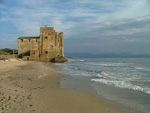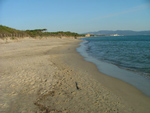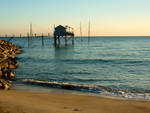The Parco Costiero della Sterpaia Maremma
The Parco Costiero della Sterpaia in Maremma Tuscany is one of those places that you can be in the midst of and not know that it is a nature park at all. That isn't to say that it isn't beautiful - it is lovely - but that you will more than probably have relaxed on one of its stretch of beaches - it is a coastal reserve - and only notice that you are stood in a protected area of Maremma when you lean on a signpost to shake off the sand from your flip flops or bucket and spades on the way back to your car or bicycle.

And whilst those very same beaches make for great seaside choices in the sweeping Gulfo di Follonica during the summer - easily accessible, ample parking (pay and display), long golden sandy stretches, shady pine woods with picnic areas behind, ample "bagno" parasol, bar and restaurant facilities - it is during the spring, autumn, and winter when the Parco Costiero comes into its own.
A place of pure tranquility, huge skies, blue ocean and space all to yourselves... Literally miles of beach framed by the curved embrace of the northern Piombino and southern Punta Ala headlands with a backdrop for dreamers: the Tuscan archipelago islands of Troia, Montecristo and even Corsica on a clear air day. And the suns favourite location in Maremma for endless stunning sunsets behind the Isola d'Elba.
It becomes a landscape photographers dream location.
Turn around and then there is the marshland - all pink in flower in the autumn.
And a magical wood ;)
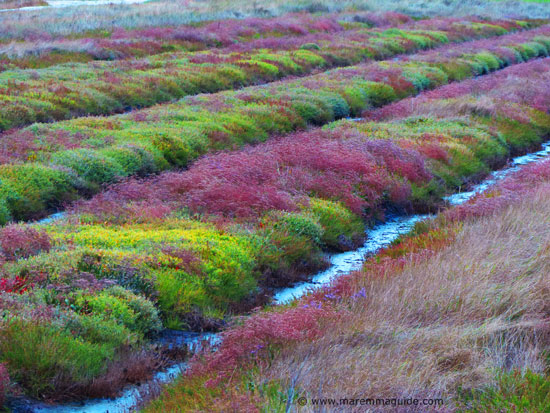
A little bit of surprising history
What was originally a extensive coastal malaria-ridden fen and dense forest first started to be drained under Cosimo d'Medici's rule in 1558 and then during the whole scale Tuscan coast reclamation project of Leopold II, the Grand Duke of Tuscany in the 19th century that changed forever the landscape of Maremma.
The Parco Costiero della Sterpaia comprises of 296 hectares: 17 hectares of beach, 124 of dunes and and 155 of woodland and agricultural land.
It was during the latter, between 1831 and 1832, that the whole of the "Lago di Piombino" - Lake of Piombino - which covered much of the area, was filled-in with sediments from dredging of the nearby river Cornia.
An impoverished land it may have been, but it was still put to use with sheep-farming, sea-water salt farming, fishing, boar hunting, and... wait for it, eeekkk, the collection of leeches for medicinal purposes.
Today's tranquility and natural state of the dunes and park, masks the fact that its more modern history has been one of a very public battle, legal wrangles, forced land expropriation and demolitions. For, although being designated in the 1970's as land destined to become a territorial public park - now the Parchi della Val di Cornia - this site was once illegally divided into two thousand private lots upon which temporary summer houses were built for 10,000 people.

It wasn't until 1998, that a battle started in 1976 by the Municipality of Piombino to restore the land to its original intent was finally won with the last demolitions of unauthorized homes. (Italy, I have to say is a mine field when it comes to building restrictions and regulations, so I can only imagine with incredulity the fraught thirty year battle that was witnessed over these beaches.)
The five beach bathing facilities - called "bagni" - that you will find along the beaches were only opened in 2004.
The beaches
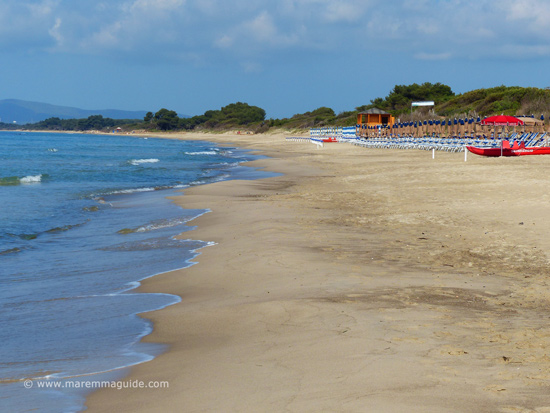 Carbonifera and Il Pino beaches all ready for the first warm weather visitors on a warm and sunny morning in early May.
Carbonifera and Il Pino beaches all ready for the first warm weather visitors on a warm and sunny morning in early May.There are no less than seven beaches covering a length of 10 kilometres in the Parco Costiero della Sterpaia; all officially Piombino beaches as the parks boundary starts where the town of Follonica's boundary ends to the north after Pratoranieri beach.
And you probably won't be surprised to learn that they are all Bandiere Blu flag beaches :)

In April the dunes are covered in a stunning bright green and pink carpet of the flowers of the succulent plant Carpobrotus acinaciformis.
There is even a beach especially designated for your pets called Dog Beach - where cats and dogs can get a let pampering too! It has to be said it isn't the prettiest stretch of coast, located as it is at the northern end of the park and under the electricity power station. And in any event, a lot of two-legged visitors don't tend to bother with following the no dog restriction on the other beaches by informing their four-legged friends.
The beaches...
 Carlappiano
Carlappiano Dog Beach
Dog Beach
All credit goes to the park authorities of the I Parchi della Val di Cornia - of which the Parco della Sterpaia is part - for, notwithstanding the large number of summer visitors each year, and that the beaches are for the most part backed by only a thin strip of dune environment and/or limited pine wood strips backing each one - many of Maremma's beaches from here southwards to the Silver Coast at Argentario have in contrast a wide "pineta" behind them in which many a Maremma campsite is nestled - the park has ample parking for both cars and caravans and campers, together with unobtrusive facilities including water supply points (and Elan waste disposal points), toilets and showers.
And wheelchair access has been provided at the main beach access points.
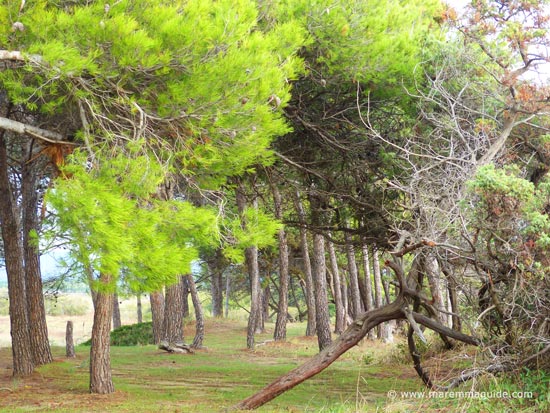
Investment in the protection of the dune and woodland environments of the Parco Naturale della Sterpaia continues today, with the reinforcement this winter (2013/2014) of the dunes fronts with natural, locally sourced materials - including large quantities of driftwood collected from the beaches, and the implementation of restricted access to the beaches via designated footpaths only.
The beach sunsets
If you can stay on the beach until the last of the suns rays cast a pink and soft blue glow across the water, sands and pine trees, then you will more often as not be treated to a spectacular sunset - "il tramonto" behind the island of Elba out in the Gulf. Only in Maremma does mixing pink and blue make a spectacular orange... ;)
 December sunset behind the Isola d'Elba from Carlappiano beach.
December sunset behind the Isola d'Elba from Carlappiano beach.
The magical wood - Il Bosco della Sterpaia

First I have to say that I have no evidence whatsoever that this wood is magical in the sense of spells, witches and wizards... But it is certainly enchanting, for three reasons.
The first one is that it is a very rare stretch of original humid forest in Italy, with centuries old oak trees, some of which have monumental trunks that take more than two to hug!
Then there is the fact that it is home to a collection of bronze sculptures - nine in all by the Florentine sculptor Marcello Guasti - each accompanied by a piece if poetry attached to fallen trees trunks.
And, lastly, because I have yet to get inside its depths! You see, apart from special event days in the spring (I'll post them here when this years dates are known) access is by appointment only and, sadly, the minimum number in a party group needs to be twenty. And me and my "explorer" daughter don't make that.
So it remains a mystery and all the more beguiling because of it. Not to be put off by the fact that we couldn't get to see inside, my youngster and I set off along the single-track access road through the Parco alongside the enclosed woodland and the plant-life immediately outside of the boundary fence looked like this!

And this...

The telephone number to call to book a guided tour is +39 0565 226445. The footpath through the wood is really easy going and suitable for wheelchairs users, and the tour takes about two hours. Depending upon the time of year you visit and the amount of rain in the days before, walking shoes are recommended, rather than flip-flops. (And a dab or two of anti-mosquito repellent!)
We have now been inside :) Take a look - the Bosco della Sterpaia.
The canals
 The Fosso Cervia canal.
The Fosso Cervia canal.You will find a lot of canals in the lowlands of Maremma: they are how the not so long ago marshes home to malaria were drained and are maintained now. In the Parco della Sterpaia you will find three immediately behind the pineta that backs the beach with footpath bridges crossing them at strategic points.
The Fosso Cervia runs the whole length of the park, a short distance behind and parallel with the beaches. The Fosso Aquaviva and Fosso Corniaccia both cross the Fosso Cervia and head inland from the sea.
When water levels are low, they aren't the most photogenic of places with an abundance of green algae slime and occasional litter... but the vegetation is regularly cut and they are home to families of Nutria (Coypu), frogs, toads, turtles and snakes - I've seen them all!
 The Carbonifera canal with its little "port".
The Carbonifera canal with its little "port".The reason for mentioning that isn't to distract from the beauty of this reserve, but to act as a reminder that you will find quite a few mosquitoes in the vicinity.
But then I don't know many Maremma beaches where you won't find a mosquito out for a jaunt too! On a sunny afternoon in the first week of January when I took some of these photos I was pestered by a rather large "zanzara" whenever I stood still enough to take a photo! January!!
The towers
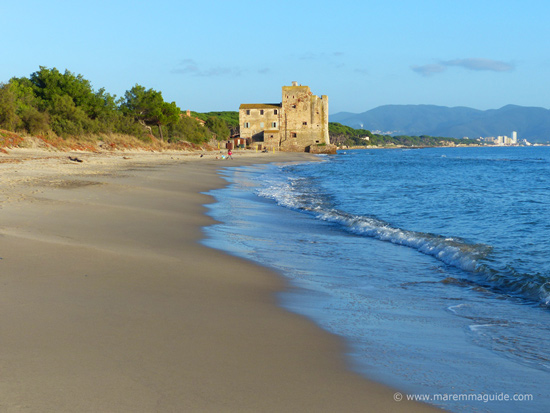 Torre Mozza and its beach in November.
Torre Mozza and its beach in November.You'll find three towers along the shoreline in the park. The southern-most is the Parco Costiero della Sterpaia's most photogenic tower and unmistakable landmark. The early sixth century tower of Torre Mozza, built as a look-out tower in the event of Saracen pirate raids - Maremma experienced a lot of those!
The second travelling northwards towards Piombino is the ninth century Torre di Carbonifera. The last point along a commercial railway line that once reached the sea bringing coal from Maremma's mines in the hills at Montebamboli.

And the third is the also ninth century Torre del Sale - Tower of Salt. Which I have to say is in the most unphotogenic of locations unless that is you like images of electricity power plants. For it is situated alongside a canal and the not so pretty sight of the ENEL power plant with its red and white striped chimneys that dominate the coastal skyline.
 The Torre del Sale. Photo by Simone Creatini
The Torre del Sale. Photo by Simone CreatiniIt takes its name from the ancient salt pans of Piombino that were situated close-by and which produced salt needed for the drying of local fish stocks and for the markets of both Siena and Firenze from where it was exported. And is waiting its turn for restoration.
But worthy of note for any birders amongst you, is that the wetland inland from the power plant is the Riserva Naturale Padule Orti - Bottagone, a WWF Oasis site, with two hundred and two (at last count) species of birds, including the "fennicotero rosa" (pink flamingo), some rarer Bittern and Purple Herons... observation huts and tower hides. Birdwatching in Maremma.
The video
The Parco Costiero della Sterpaia map
Where to stay

Just a short distance from the Parco Costiero della Sterpaia and its beaches you will find the much loved and air-conditioned self-catering apartments of the Villagio Turistico Airone. With on-site restaurants you can choose to eat out when you want to without needing to drive anywhere. The complex also has an outdoor swimming pool and free wi-fi.
Explore some more...
